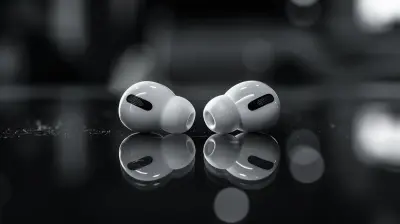The Science Behind Fitness Trackers: How They Actually Work
8 August 2025
Fitness trackers have taken the world by storm. Whether you're aiming to crush your step count, improve sleep, or monitor heart health, these tiny gadgets promise big results. But have you ever wondered how they actually work? What’s the science behind these wearable health tools?
In this article, we're diving deep into the technology inside fitness trackers, explaining how they measure movement, heart rate, sleep, and more. By the end, you'll have a clear understanding of how these little devices keep tabs on your health—and whether they're really worth it!
![]()
How Fitness Trackers Measure Movement
At the core of every fitness tracker is a motion sensor, specifically an accelerometer. This component detects movement by measuring changes in velocity. When you walk, run, or even fidget, the accelerometer records these motions and translates them into digital data.But that’s not all! Some high-end trackers also come with a gyroscope and a magnetometer.
- Accelerometer – Measures movement in three directions (up/down, forward/backward, side-to-side).
- Gyroscope – Helps detect rotational movements, like turning your wrist.
- Magnetometer – Identifies orientation and direction, assisting with GPS tracking.
By combining data from these sensors, your tracker can estimate how many steps you've taken, how fast you're moving, and even recognize different exercises.
Are Step Counts Accurate?
You’ve likely wondered whether your fitness tracker is actually counting all your steps correctly. The truth? They're pretty accurate, but not perfect. Since they rely on motion detection, sudden movements (like waving your hand) can sometimes be miscounted as steps.To improve accuracy, most modern devices use machine learning algorithms that analyze movement patterns and filter out "false steps." This makes them much more reliable—but not 100% precise.
![]()
The Technology Behind Heart Rate Monitoring
Heart rate tracking is one of the most beloved features of fitness trackers. But how do they measure your pulse without a chest strap? The answer lies in PPG (Photoplethysmography).PPG works by shining green LEDs onto your skin. Your blood absorbs green light more than other colors, and as your heart beats, the volume of blood flowing through your wrist changes. The tracker detects these changes by measuring the variation in light absorption, giving you a heart rate reading.
Is Wrist-Based Heart Rate Monitoring Accurate?
While fitness trackers do a decent job of measuring pulse when you're at rest or doing moderate activities, they struggle with high-intensity workouts. Factors like sweat, movement, or loose-fitting straps can interfere with accuracy.For athletes or those needing precise heart rate readings, a chest strap monitor (which measures electrical activity like an ECG) is still the gold standard.
![]()
Sleep Tracking: How Do They Know You're Asleep?
Ever wondered how your fitness tracker knows when you've fallen asleep? It all comes down to your movement patterns and heart rate.Most devices track sleep using a combination of:
- Accelerometer Data – Less movement typically signals you're asleep.
- Heart Rate Variability – Your heart rate tends to slow and fluctuate differently during sleep.
Some advanced wearables also use skin temperature sensors or oxygen level monitoring (SpO2) to detect breathing patterns, helping to identify conditions like sleep apnea.
How Accurate Is Sleep Tracking?
While fitness trackers can estimate sleep duration fairly well, they struggle to accurately measure sleep stages (REM, light, deep sleep). Professional sleep studies use EEG (electroencephalography) to track brain activity—something current wearables don't have.So, while your tracker can help you understand sleep trends, it’s not as precise as a lab sleep study.
![]()
Measuring Calories Burned: Science or Guesswork?
One of the biggest draws of fitness trackers is their ability to estimate calories burned. But are these numbers trustworthy?The truth is, calorie estimates aren’t always accurate. Trackers rely on a combination of:
- Movement Sensors – More intense movement = more calories burned.
- Heart Rate Data – A higher heart rate can indicate higher energy expenditure.
- User Data – Your age, weight, height, and gender influence calorie burn calculations.
However, since they don’t measure metabolism directly, these numbers should be taken as a rough estimate, not an exact science.
GPS and Distance Tracking
If your fitness tracker has built-in GPS, it can track your runs, walks, or bike rides more accurately than step-counting alone. GPS works by connecting to satellites to calculate your movement across distances.Some trackers rely on your phone's GPS instead of having their own. This is called Connected GPS—it saves battery life but requires your phone to be nearby for precise tracking.
GPS vs. Step Counting: Which One Is Better?
If you’re serious about accurately measuring runs or hikes, GPS is far superior to step counting. It tracks real distance and speed, while step counting only estimates based on motion data.
Oxygen Levels (SpO2) and Blood Flow Monitoring
Some premium trackers now include SpO2 sensors, which measure blood oxygen levels. This is done using red and infrared light sensors that detect how much oxygen is in your bloodstream.Why does this matter? Monitoring SpO2 can help detect potential health issues like sleep apnea or respiratory problems. However, the readings on wearables aren't medical-grade—they provide general insights but shouldn’t replace professional testing.
The Role of AI and Machine Learning in Fitness Trackers
Fitness trackers have come a long way, thanks to artificial intelligence (AI) and machine learning. These technologies analyze vast amounts of data from millions of users to improve accuracy and provide personalized insights.For example, your tracker might learn your typical movement patterns and become better at distinguishing between actual steps and random hand motions. Some even offer coaching advice based on your fitness trends!
Future of Fitness Trackers
With advancements in AI, health sensors, and even blood sugar monitoring, fitness trackers are expected to become even smarter and more precise in the future. Some experts even believe they could help detect early signs of diseases!
Are Fitness Trackers Worth It?
At the end of the day, fitness trackers are fantastic tools for tracking progress, staying motivated, and improving overall health. Sure, they’re not perfect, but they give you a solid overview of your daily activity, sleep, and heart health.If you’re after hyper-accurate data (like precise calories burned or sleep cycles), they might fall short. But if you want a general guide to healthy habits, they’re an excellent investment!
Final Thoughts
Fitness trackers are packed with cutting-edge technology, from motion sensors and heart rate monitors to AI-powered insights. While they aren't flawless, they provide valuable data that can help you stay fit and make healthier choices.So, next time you glance at your step count or heart rate on your wrist, you'll know exactly how it's being measured—and appreciate the science behind it!
all images in this post were generated using AI tools
Category:
Fitness TrackersAuthor:

Gabriel Sullivan
Discussion
rate this article
1 comments
Payton Gill
Fitness trackers: the little wrist buddies that turn sweat into data! They’re like personal cheerleaders, measuring every step and heartbeat, proving that even numbers can keep us moving and grooving!
August 23, 2025 at 10:29 AM

Gabriel Sullivan
Thanks for the fun take! Fitness trackers really do transform our workouts into actionable data, motivating us to stay active and improve our health.


